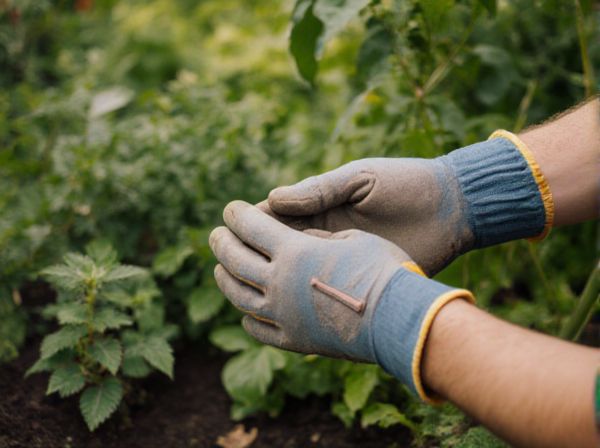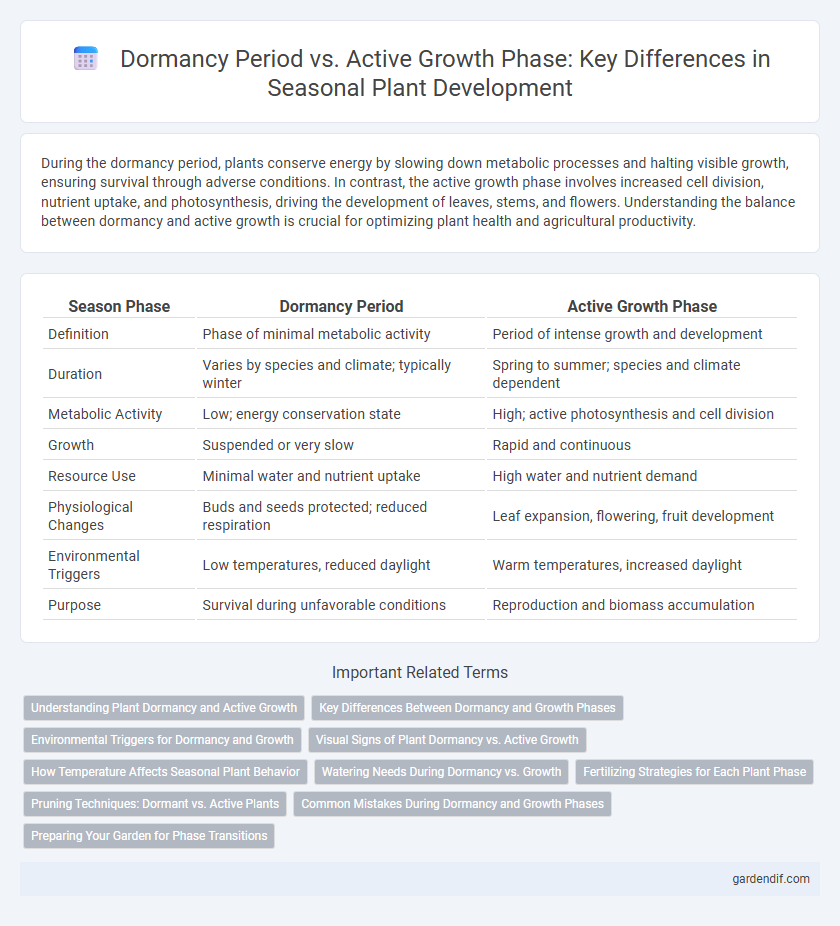
Dormancy period vs Active growth phase Illustration
During the dormancy period, plants conserve energy by slowing down metabolic processes and halting visible growth, ensuring survival through adverse conditions. In contrast, the active growth phase involves increased cell division, nutrient uptake, and photosynthesis, driving the development of leaves, stems, and flowers. Understanding the balance between dormancy and active growth is crucial for optimizing plant health and agricultural productivity.
Table of Comparison
| Season Phase | Dormancy Period | Active Growth Phase |
|---|---|---|
| Definition | Phase of minimal metabolic activity | Period of intense growth and development |
| Duration | Varies by species and climate; typically winter | Spring to summer; species and climate dependent |
| Metabolic Activity | Low; energy conservation state | High; active photosynthesis and cell division |
| Growth | Suspended or very slow | Rapid and continuous |
| Resource Use | Minimal water and nutrient uptake | High water and nutrient demand |
| Physiological Changes | Buds and seeds protected; reduced respiration | Leaf expansion, flowering, fruit development |
| Environmental Triggers | Low temperatures, reduced daylight | Warm temperatures, increased daylight |
| Purpose | Survival during unfavorable conditions | Reproduction and biomass accumulation |
Understanding Plant Dormancy and Active Growth
Plant dormancy is a survival strategy during adverse conditions characterized by minimal metabolic activity and halted growth. In contrast, the active growth phase involves accelerated cell division, nutrient uptake, and photosynthesis, enabling plants to develop leaves, flowers, and fruits. Understanding these phases is crucial for optimizing agricultural practices, ensuring proper timing for planting, pruning, and harvesting to maximize crop yield.
Key Differences Between Dormancy and Growth Phases
Dormancy period is characterized by minimal metabolic activity and halted growth, serving as a survival strategy during unfavorable environmental conditions such as winter or drought. In contrast, the active growth phase features heightened metabolic processes, cell division, and elongation, driven by optimal temperature, light, and water availability. Key differences include energy consumption levels, with dormancy utilizing stored reserves and growth phase relying on photosynthesis and nutrient uptake for biomass accumulation.
Environmental Triggers for Dormancy and Growth
Environmental triggers for dormancy in plants primarily include decreasing daylight hours and lowering temperatures, signaling the onset of unfavorable conditions. The active growth phase resumes when increasing temperatures and longer daylight periods provide optimal energy for photosynthesis and cellular activities. Soil moisture levels and nutrient availability also play critical roles in signaling transitions between dormancy and growth phases.
Visual Signs of Plant Dormancy vs. Active Growth
Leaf color transformation from vibrant green to muted brown or yellow signals plant dormancy, while fresh, bright green shoots indicate active growth. Buds in dormancy appear tight and closed, contrasting with swollen, open buds during the growth phase. Stem texture also changes: dormant stems are often hard and brittle, whereas actively growing stems are tender and flexible.
How Temperature Affects Seasonal Plant Behavior
Temperature plays a crucial role in regulating the dormancy period and active growth phase of plants by triggering biochemical changes that either halt or promote cellular activity. During colder seasons, low temperatures induce dormancy, conserving energy and protecting plants from frost damage, while warmer temperatures stimulate enzyme activity and metabolic processes essential for active growth. These temperature variations ensure plants synchronize their life cycles with seasonal patterns, optimizing survival and reproductive success.
Watering Needs During Dormancy vs. Growth
During the dormancy period, plants require significantly less water as their metabolic activities slow down and water uptake decreases to prevent root rot. In contrast, the active growth phase demands increased watering to support cell expansion, nutrient transport, and overall development. Properly adjusting watering schedules according to these phases ensures optimal plant health and growth efficiency.
Fertilizing Strategies for Each Plant Phase
During the dormancy period, plants require minimal fertilization, focusing on low-nitrogen, high-potassium formulas to promote root strength and prepare energy reserves. In the active growth phase, nutrient-rich fertilizers with balanced nitrogen, phosphorus, and potassium ratios support vigorous foliage development, flowering, and fruit production. Tailoring fertilizing strategies to each plant phase optimizes nutrient uptake, enhances growth efficiency, and improves overall plant health.
Pruning Techniques: Dormant vs. Active Plants
Pruning techniques differ significantly between the dormancy period and the active growth phase, as plants exhibit varied physiological responses. During dormancy, pruning is focused on removing dead or weak branches to stimulate healthy growth in the next season, minimizing sap loss and stress. In contrast, pruning active plants requires careful timing and selective cuts to avoid disrupting photosynthesis and to promote immediate healing and vigorous development.
Common Mistakes During Dormancy and Growth Phases
Common mistakes during the dormancy period include overwatering and exposing plants to excessive light, which disrupts natural rest cycles and deplete energy reserves. During the active growth phase, underwatering and neglecting nutrient requirements can stunt growth and reduce plant vitality. Proper monitoring of soil moisture and balanced fertilization are critical to support healthy transitions between dormancy and active growth.
Preparing Your Garden for Phase Transitions
Preparing your garden for seasonal phase transitions involves understanding the dormancy period and the active growth phase. During dormancy, plants conserve energy and require minimal watering, while the active growth phase demands increased nutrients, consistent watering, and pruning. Adjusting soil quality and monitoring temperature fluctuations ensures healthy plant development and seamless transition between these growth cycles.
Dormancy period vs Active growth phase Infographic

 gardendif.com
gardendif.com